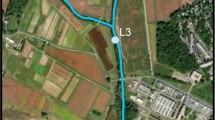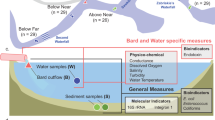Abstract
To examine the factors contributing to microbial heterogeneity, the US Department of Energy Subsurface Science Program has initiated research at a Coastal Plain site near Oyster, VA. Sediments at the site are composed of unconsolidated, fine to coarse beach sands and gravel. The influence of microbiological culture media on the measurement of colony-forming units (CFU) and microbial diversity was examined in this study. Two low-nutrient media formulations (i.e., dilute peptone, tryptone, yeast extract, and glucose medium [PTYG] and a soil extract medium) gave equivalent estimates of CFU (maximum of about 6.5 × 105 CFU/g). However, a higher nutrient medium, organic nutrients with brain-heart infusion (N/BHI), gave lower numbers than the dilute PTYG. A medium used to enumerate fungi also gave significantly lower counts than the dilute PTYG medium. Although the correlations were highly significant among total CFU numbers measured with the different types of media, we found few significant correlations in several indices of microbial diversity, and the correlation coefficients were below 0.25. Thus, CFU was a relatively robust measurement, but microbial diversity was not consistent between the media. Species richness was highest with the higher nutrient N/BHI medium, and N/BHI may be a better choice for a study of diversity as determined by colony morphology.
Similar content being viewed by others
References
Kaneko, T., Atlas, R. M., and Krichevsky, M. (1977),Nature 270, 596–599.
Mills, A. L. and Wassel, R. A. (1980),Appl. Environ. Microbiol. 40, 578–586.
Atlas, R. M. (1984), inCurrent Perspectives in Microbial Ecology, Klug, J. and Reddy, C. A., eds., American Society for Microbiology, Washington, DC, pp. 540–545.
Atlas, R. M. (1984), inAdvances in Microbial Ecology, vol. 7, Plenum, New York, pp. 1–47.
Bone, T. L. and Balkwill, D. L. (1988), Microb. Ecol.16, 49–64.
Balkwill, D. L., Fredrickson, J. K., and Thomas, J. M. (1989),Appl. Environ. Microbiol. 55, 1058–1065.
Fredrickson, J. K., Balkwill, D. L., Zachara, J. M., Li, S. W., Brockman, F. J., and Simmons, M. A. (1991),Appl. Environ. Microbiol. 57, 402–411.
Balkwill, D. L. and Ghiorse, W. C. (1985),Appl. Environ. Microbiol. 50, 580–588.
Brockman, F. J., Kieft, T. L., Fredrickson, J. K., Bjornstad, B. N., Li, S.-M. W., Spangenburg, W., and Long, P. E. (1992),Microb. Ecol. 23, 279–301.
Difco (1984),Difco Manual: Dehydrated Culture Media and Reagents for Microbiology, Difco Laboratories, Detroit.
Balkwill, D. (1989),Geomicrobiol. J. 7, 33–52.
Mixon, R. B. (1985), US Geol. Surv. Prof. Paper. 1067-C, pp. 53.
Russell, B., Phelps, T. J., Griffin, T., and Sargent, K. L. (1992),Water Well Winter 92, 96–104.
Smibert, R. M. and Krieg, N. R. (1994),Methods for General and Molecular Bacteriology, Gerhardt, P., Murry, R. G. E., Wood, W. A., and Krieg, N. R., eds., American Society for Microbiology, Washington, DC, pp. 607–654.
Odum, E. P. (1971),Fundamentals of Ecology. W. B. Saunders Co., Philadelphia.
Palumbo, A. V., Zhang, C., Phelps, T. J., Pfiffner, S. M., Ringleberg, D., and Chapatwala. K.Microb. Ecol. Submitted for publication.
Chapatwala, K. D., Babu, G. V., Armstead, E., Palumbo, A. V., Zhang, C., and Phelps, T.,Appl. Biochem. Biotechnol. 57/58, 813–821.
Bianchi, M. A. G. and Bianchi, A. J. M. (1982),Microb. Ecol. 8, 61–69.
Olsen, K. D. and Sizemore, R. K. (1981),Dev. Ind. Microbiol. 22, 685–694.
Troussellier, M. and Legendre, P. (1981),Microb. Ecol. 7, 283–296.
Hauxhurst, J. D., Kaneko, T., and Atlas, R. M. (1981),Microbial. Ecol. 7, 167–182.
Stahl D. A., Lane, D. J., Olsen, G. C., and Pace, N. R. (1984),Science 224, 409–411.
Stahl D. A., Lane, D. J., Olsen, G. C., and Pace, N. R. (1985),Appl. Environ. Microbiol. 49, 1379–1384.
Muyzer, G., De Wall, E. C., and Uitterlinden, A. G. (1993),Appl. Environ. Microbiol. 59, 695–700.
Fuhrman, J. A., McCallum, K., and Davis, A. A. (1993),Appl. Environ. Microbiol. 59, 1294–1302.
Moyer, C. L., Dobbs, F. C., and Karl, D. M. (1994),Appl. Environ. Microbiol. 60, 871–879.
Haldeman, D. L. and Amy, P. S. (1993),Appl. Environ. Microbiol. 59, 933–935.
Author information
Authors and Affiliations
Additional information
Oak Ridge National Laboratory is managed by Martin Marietta Energy Systems, Inc., for the US Department of Energy under contract DE-AC05-84OR21400.
The submitted manuscript has been authored by a contractor of the US government under contract No. DE-AC05-840R21400. Accordingly, the US government retains a nonexclusive, royalty-free license to publish or reproduce the published form of this contribution, or allow others to do so, for US government purposes.
Rights and permissions
About this article
Cite this article
Palumbo, A.V., Zhang, C., Liu, S. et al. Influence of media on measurement of bacterial populations in the subsurface. Appl Biochem Biotechnol 57, 905–914 (1996). https://doi.org/10.1007/BF02941771
Issue Date:
DOI: https://doi.org/10.1007/BF02941771




